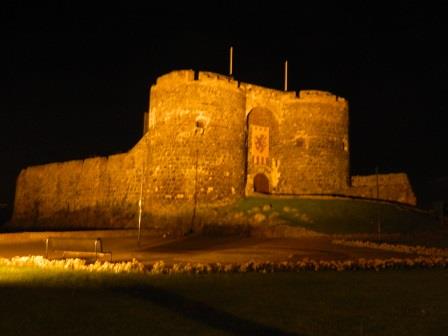English Governor loses his head in dispute with ClanDonnell
The McDonnells fought a 20-year war against England in the late 16th Century. This was one Irish clan versus an entire country. Surprisingly, the war did not end with an English victory. Instead, it ended in a draw!
In the negotiated peace, each side got what it wanted. ClanDonnell got to keep its lands – the Glens of Antrim, County Antrim and some other nearby lands. England got the recognition it wanted: the McDonnells recognized Queen Elizabeth as their queen, and her successors as their monarch.
A decade after that peace, another rebellion broke out in Ireland. This was the bloodiest war ever fought on the island of Ireland. It is usually called the Nine Years War, which is funny name for any war, particularly for this one which lasted 10 or 12 years.
This rebellion was led by three other Ulster clans – the O’Neills, the O’Donnells and the Maguires – but eventually spread to most of Ireland. But the McDonnells stayed out of it, at least initially. The clan honored their peace with the English.
The English governor of Carrickfergus, at the time, was John Chichester. In light of the war raging elsewhere, one would think that Governor Chichester would be a bit diplomatic when dealing with the McDonnells.
Decades earlier, a Spanish ship from the Spanish armada crashed into the shores of Antrim, near Dun Luce Castle. The McDonnells rescued many Spanish sailors and also salvaged a huge cannon which was on board the ship. The cannon was pulled out of the sea by divers and restored to working order.

The McDonnells mounted the cannon on the walls of Dunluce Castle. Chichester demanded that the McDonnells remove the cannon from Dunluce and deliver it to Carrickfergus. The McDonnells replied, in the parlance of the era – fuck off.
Members of the clan also had several run-ins with English tax collectors in Antrim. By run-ins, I mean clan warriors ran off the English tax collectors.
Chichester thought that the McDonnells, particularly clan chief James McDonnell, were being disloyal to England. And so, in November 1597, Chichester summoned James to meet with him in Carrickfergus.
James showed up, but not alone. He brought with him his clan army of clan, and he and his army stopped a few miles short of Carrickfergus.
Chichester rode out to meet him, and he too brought with him a small army of English soldiers. Both sides were equally ready for a negotiation or a battle
The two sides sent messengers back and forth for a while in negotiation. Chichester grew irritated with the progress, and with the McDonnells show of force. He then told his second in command:
“Give them a charge, so that we might have a good killing upon them, or at least take a good run out of them.”
Chichester clearly underestimated the McDonnell battle skills, and over estimated that of his own army. Many of these English soldiers had just arrived to Carrickfergus after a long march, and much of their powder was wet.
With Chichester’s order, half of his calvary charged, but the other half did not – they turned around and rode to Carrickfergus. He ordered his foot soldiers to attack, but with their powder wet, English muskets were useless.
The McDonnells followed up with an attack of their own, on both flanks. In the face of this charge, the English soldiers turned and ran away.
Chichester struck one of his own men with his sword for running away. He was then shot in the leg. Chichester started to ride back to Carrickfergus but was shot in the head about halfway there.
In all, 170 English soldiers killed. Another 30 or 40 wounded. While some made it directly back to Carrickfergus, others hid in a nearby forest. They made it back to Carrickfergus one by one over the next several days.
The McDonnells delivered the bodies of John Chichester and his second in command to Carrickfergus. Both bodies were headless.
There are many stories about what happened to the head of Governor Chichester. The most believable story is that the head was delivered by the McDonnells to the O’Neills as a gift.
It was used by the O’Neills as a ball in an early form of Gaelic football.
The photograph at the top is of Carrickfergus, and that in the middle is of Dunluce, both by Linda McDonnell. The photo below shows players in the Gaelic Athletic Association, from The University Observer. It doesn’t take too much imagination to see them playing the game with the head of an English governor.

